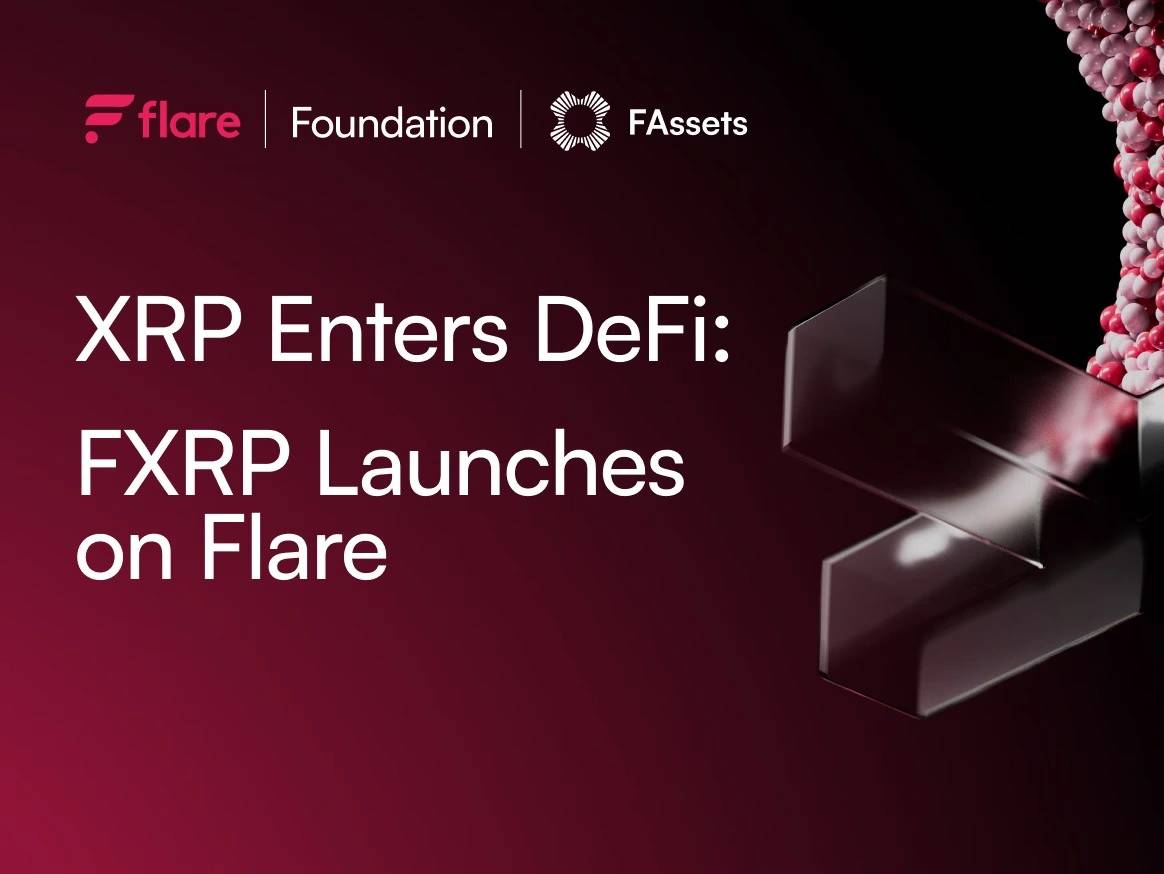订阅 wiki
Share wiki
Bookmark
FXRP
FXRP
FXRP 是 Flare 网络上 XRP 代币的一种一对一、超额抵押的表示。它是使用 Flare 的 FAssets 系统创建的第一个资产,该协议旨在使非智能合约加密货币能够以非托管方式在去中心化金融 (DeFi) 应用程序中使用。
概述
FXRP 由 Flare 网络开发,旨在将 XRP(XRP 分类账的原生加密货币)集成到 Flare 的 EVM 兼容 DeFi 生态系统中。主要目标是为 XRP 持有者解锁新的实用性,使他们能够参与借贷、提供流动性以及参与流动质押等活动,而无需依赖中心化托管人或中介机构。该代币旨在作为 Flare区块链上的可替代 ERC-20 资产运行,使其与各种智能合约和 DeFi 协议兼容。[1] [2]
支撑 FXRP 的 FAssets 系统以非托管和超额抵押框架运行。这意味着用户可以铸造 FXRP,而无需将基础资产的控制权交给第三方,并且该系统维护的储备价值高于流通中的 FXRP,以确保其稳定性和安全性。该计划是 Flare 更广泛战略的一部分,该战略被称为“XRPFi”,旨在为 XRP 在 DeFi 领域建立强大且可组合的角色。[3] [4]
历史
该项目的概念起源可以追溯到 2018 年 Flare 联合创始人 Hugo Philion 和 Ripple 首席技术官 David Schwartz 之间的一次对话,Philion 称这次对话对该项目的发展产生了影响。在 主网 部署之前,FAssets 协议和 FXRP 在 Flare 的金丝雀网络 Songbird 上进行了广泛的测试,其中发布版本 v1.2 通过了其最终安全里程碑。[5] [1]
FXRP 于 2025 年 9 月 24 日在 Flare 主网 上正式启动。为了确保稳定和安全的推出,该启动采用了一种渐进式方法进行管理,在第一周实施了 500 万 FXRP 的初始铸币上限,并计划随着时间的推移增加此限制。此次发布获得了显着的早期采用,有报告表明,超过 710 万美元的 XRP 被锁定在 Flare 的金库中,并且在可用后的最初几个小时内铸造了 500 万 FXRP。[3] [6]
技术
FXRP 的功能基于 FAssets 协议,该系统由 Flare 开发,用于创建来自非智能合约区块链的资产的无需信任、可替代的 ERC-20 表示。
FAssets 系统
FAssets 协议是支持 FXRP 创建的核心技术。它旨在处理跨链流程,包括 抵押品 管理和无需信任的桥接,以安全地将 XRP 等资产引入 Flare 网络。该系统被设计为非托管的,允许用户铸造和赎回 FAssets,而无需将原始代币的控制权交给中心化实体。Flare 计划扩展 FAssets 系统以支持其他主要的非智能合约加密货币,包括 比特币 (BTC) 和 狗狗币 (DOGE)。[4] [5]
铸造和赎回
用户可以通过称为铸造的过程创建 FXRP。这涉及在支持 XRP 分类账和 Flare 网络的自托管钱包(例如 Ledger 或 Bifrost)中持有原生 XRP。通过专用的 dApp 或门户,用户存入他们的 XRP,然后通过 Flare 上的独立“代理”网络将其锁定为抵押品。此操作会在 Flare 网络上铸造等量的 FXRP。该协议还旨在促进赎回,允许用户销毁他们的 FXRP 以解锁并取回他们在 XRP 分类账上的原始 XRP。[2] [1]
核心架构和安全性
FXRP 系统的安全性依赖于其超额抵押设计和 Flare 的原生数据协议。该系统确保代理持有的抵押品价值超过流通中的 FXRP 价值。此框架由两项关键的链上数据服务支持:
这些协议允许系统以去中心化和可审计的方式运行,而无需依赖单一的可信数据源。为了进一步确保其完整性,FAssets 协议已经过广泛的安全验证措施。[3]
这些安全措施包括:
- 审计: 该系统已经过至少四次独立的安全性审计,由 Zellic 和 Coinspect 等公司进行。
- 社区审查: 代码库通过 Code4rena 平台接受了社区主导的审查。
- 漏洞赏金: 通过 Immunefi 管理主动漏洞赏金计划,以激励安全研究。
- 持续监控: 该协议及其集成应用程序受到安全公司 Hypernative 的 24/7 监控。
这种多层安全方法旨在降低风险并确保协议内用户资金的安全。[7] [4]
采用和激励
为了鼓励采用并在启动时引导流动性,Flare 网络启动了一项激励计划。Flare 排放委员会的任务是将网络的原生奖励代币 rFLR 分发给参与 FXRP 生态系统的用户。在启动时,受支持的去中心化交易所上的 FXRP/USDT₮0 等流动性池提供高达 50% 的年化百分比率 (APR)。Kinetic 等平台上的借贷市场提供约 5% 的供应 APR。这些激励措施旨在吸引早期用户并为 Flare DeFi 生态系统中的 FXRP 建立深厚的流动性基础。[3] [1]
除了直接铸造外,用户还可以通过在基于 Flare 的去中心化交易所上将其他代币兑换为 FXRP 来获得 FXRP。此次发布还得到了 VivoPower 宣布的 1 亿美元投资的支持,旨在扩大 XRP 在 DeFi 市场中的功能,这表明机构对该计划的兴趣。[2] [6]
用例
FXRP 是一种基础资产,它本身不会产生收益;相反,它旨在部署在 Flare 网络上的各种 DeFi 协议中,以赚取收益并访问金融服务。
当前用例
- 交易和流动性提供: FXRP 可以在去中心化交易所 (DEX) 上进行交易,并提供给流动性池,允许用户赚取交易费用和流动性挖矿奖励。
- 借贷: 用户可以将 FXRP 提供给借贷协议以赚取利息,或将其用作抵押品来借用其他加密资产。
未来用例
- 流动性质押: 项目 Firelight 计划发布一种流动质押衍生品 stXRP。这将允许用户质押他们的 FXRP 以赚取奖励,同时获得可在其他 DeFi 应用程序中使用的流动代币。
- 稳定币: 计划将 FXRP 用作在 Enosys Loans 等平台上铸造基于抵押债务头寸 (CDP) 的稳定币的抵押品。
- 结构化产品: 开发路线图包括创建围绕 stXRP 和 FXRP 构建的收益金库和其他结构化金融产品。
这些不断扩展的用例旨在加深 XRP 在更广泛的 DeFi 格局中的集成。[7] [4]
生态系统
在启动时,FXRP 得到了 Flare 生态系统中的一系列协议和钱包的支持。
- 去中心化交易所 (DEX): SparkDEX、BlazeSwap 和 Enosys。
- 借贷协议: Kinetic。
- 钱包: 支持铸造过程的钱包包括 Ledger 和 Bifrost。支持该代币的通用钱包包括 Luminite 和 Oxen Flow。
与这些平台的集成为 FXRP 在发布时提供了即时实用性。[5] [2]
评论
FXRP 的发布已被关键人物描述为 Flare 网络和 XRP 社区的一个重要里程碑。Flare 联合创始人 Hugo Philion 表示:“这是一个重要的时刻,既是我们自始至终所做工作的顶峰,也是下一个阶段的开始。”[5]
Flare 首席产品官 Filip Koprivec 强调了技术设计,并指出:“这里的不同之处在于,FXRP 被设计为非托管和超额抵押的,具有链上、协议级别的验证,而不是信任单一托管人。”[3]
然而,一些社区成员也发布了关于与高收益 DeFi 产品相关的风险的警告。XRP验证器 Vet_XO 警告投资者,称“每一盎司的收益都由一定数量的风险支付……一些项目会跑路并破产”,提醒参与者去中心化金融领域固有的风险。[5]
发现错误了吗?
